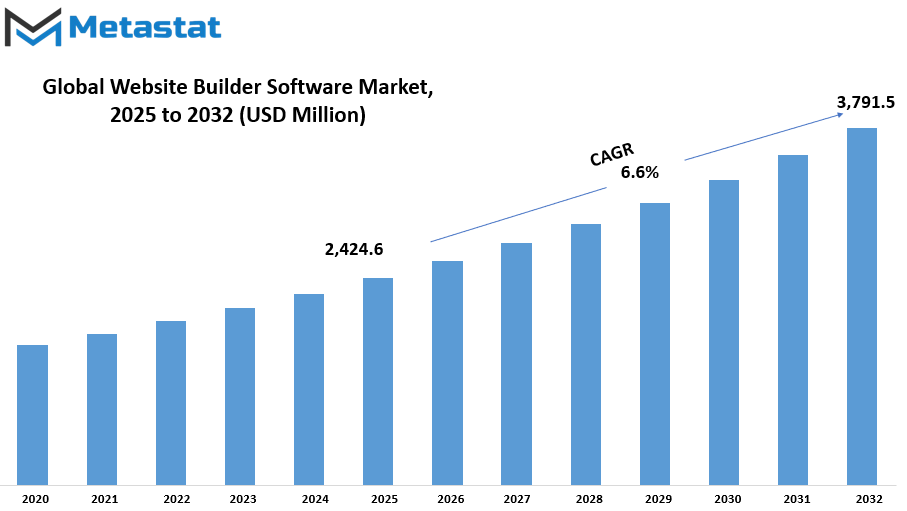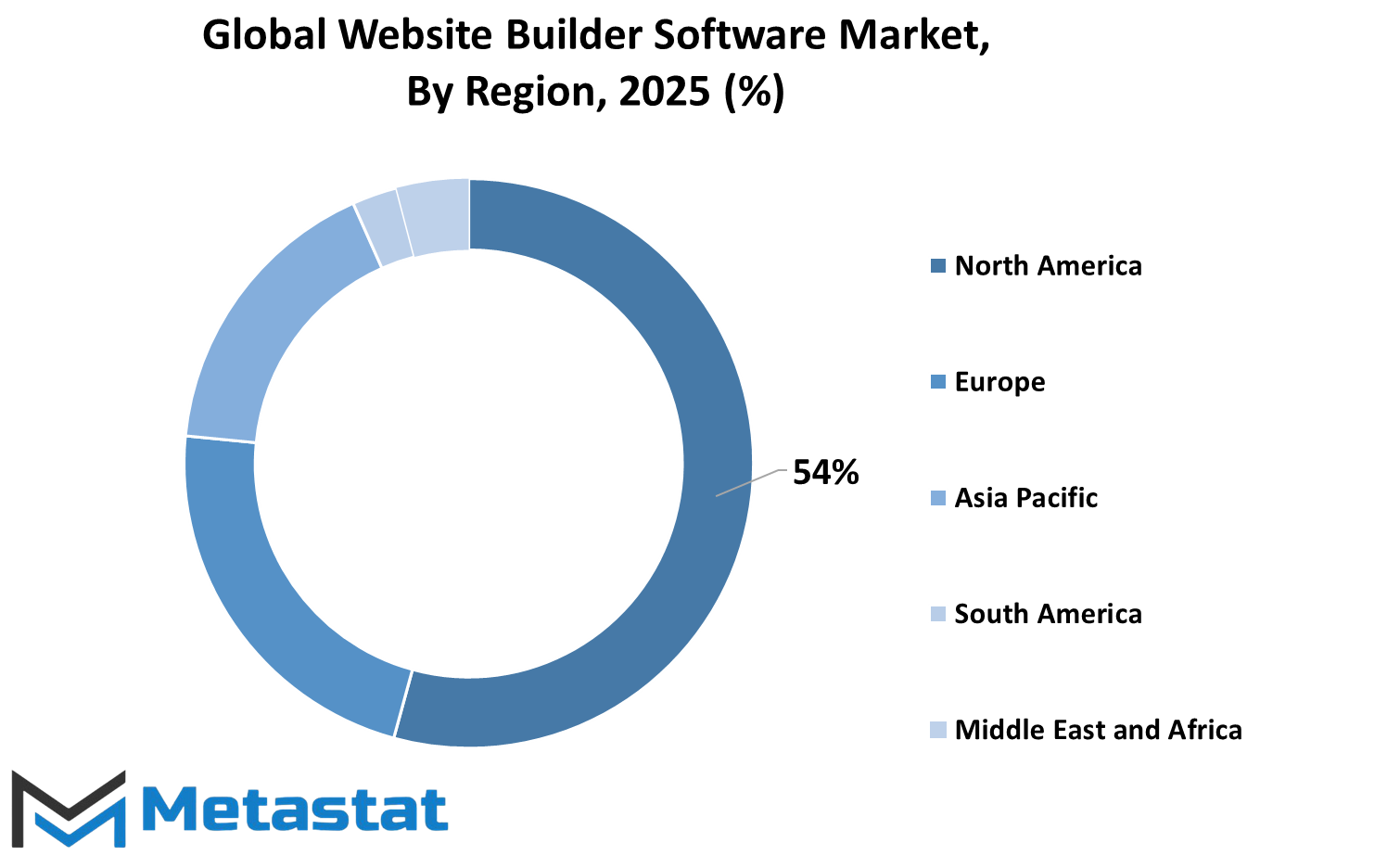MARKET OVERVIEW
The Global Website Builder Software market is at an intersection where, for the first time, innovation, consumer behavior, and technological maturity will combine to create an unforeseen turn of events in market history. The industry has so far been on a path where the future of creating an online presence will have a lot to do with how it is shaped by demand or price competition; it will not be so in the near future. The market will be pushed forward with personalization engines, backend automation, and user-intent forecasting, which are going beyond the traditional application. Under those settings, software providers will also be looking for tighter integration into content intelligence and UX design tools, developing their products from simple drag-and-drop templates into responsive and intelligent design-oriented platforms.
Changing the way users engage with these website builders constitutes a core transformation. These builders will no longer remain isolated tools; they will now work closely together with AI-led design advisors and third-party applications that possibly interpret user intentions. These systems will predict what kind of a website a user may want to build based on historical data, behavioral input, and trends in the business sector. Henceforth, the Global Website Builder Software domain will start noticing platforms that pitch themselves as intelligent co-creators and not merely passive utilities.
The industry will then also go toward solutions for dynamic content that would be reactionary according to the behavior of the visitors. The digital footprints are getting really messy in terms of interactions, and website builders will be expected to meet increasingly robust and sophisticated personalization really means real-time content-switching, adaptive media placements, and predictive layout changes-without any demands on the user for advanced coding. Vendors who provide software will then turn their attention to engineering tools that will let non-techies make use of professional-grade capabilities.
Security protocols within the Global Website Builder Software market will change, too. With websites operating on a higher gradient of user data, there is a need for software solutions to have higher levels of encryption and real-time threat detection built right into them. The burden will shift from end-users to software providers who will carry the expectation of providing continued compliance with local and global data protection laws. Security architecture will be integrated in a way that helps enforce such compliance, where certain processes like automated backups, certificate renewals, and malware scanning will be automated in key development processes.
Another dynamic that will impart influence to the industry is that of increasing sustainability and server efficiency. Future generations of tools will work to keep any code that's not necessary from being added, minimize hosting demands, and reduce the overall digital carbon footprint. The Global Website Builder Software market will investigate strategies rooted in minimalist architecture, whereby performance will not be reduced but actively promote greener deployment.
Global Website Builder Software market is estimated to reach $3,791.5 Million by 2032; growing at a CAGR of 6.6% from 2025 to 2032.

GROWTH FACTORS
It is clearly written about the globally increasing software market that concentrates on web building within the steady growth of the market because more and more individuals and companies are adopting the necessity of being online. Presently, online visibility is not an option; it's an immediacy of businesses of all ranges-that from being small to micro, small-and-medium enterprises (MSMEs) are increasingly embracing website-building software as it entitles them to not have to really have advanced technical skills to have an easy-to-use, low cost form of website creation and management; and, as much as the cheaper, it saves time and money while reaching a wider audience for professional-looking websites.
The other reason it actually gives a boost for the market is the growing inclination toward e-commerce. With most businesses opting for e-commerce in selling products and services, they need a reliable site for that. Most website builder software typically comes with features such as shopping carts, payment gateways, and user-friendly design tools that simplify the process of starting and managing an online store. With the increasing online customers, the demand for these platforms is increasing.
Even though it is showing growth, the market is not without challenges. One is the technical limitation of drag-and-drop. It is by such ubiquity in which it renders the feature as just being easy, especially when it comes to the depth and flexibility a more professional user or developer may desire. This could thus lead to restrictions on what a user might do with his or her site, especially if the user desires advanced functionalities or a rather unique design. Due to this reason, some enterprises outgrow such constraints and seek other alternatives.
There is also increased competition from open-source websites: These platforms are mostly free and provide a greater level of customization, thus making them more attractive to a developer and the end users in need of sufficient control. Hence, competition from such open-source platforms is believed to slow down the growth of paid website builder software, especially in those markets where the user is highly tech-savvy.
The website builder software market has a bright destiny. As online selling keeps increasing particularly for new startups with limited funds and small businesses, there lies a huge responsibility on the market to continue coming up with effective yet simple website tools. Building these sites online would remain sought after by many companies. Website builder software can meet this purpose through new updates and features so that it can remain competitive and provide value to users in many ways for decades to come.
MARKET SEGMENTATION
By Type
The Global Website Builder Software market has been steadily growing due to the increasing need for corporate or individual online presence. What the software does is allows users to create websites without digging into the technical know-how often preferred by bigger companies-out to set up websites as fast and cheaply as possible. One of the divisions in which this market is divided is based on the type of website being constructed: Static and Dynamic. The Static Website segment is attracting much interest and, being in the neighborhood of $1406.5 million, is an important one. Static websites are generally easier and quicker to put up and are used by sites that do not need to be updated or require complicated interactions often. These are best suited for small portfolios, company landing pages, or just informational websites that rarely change.
Dynamic websites, however, are meant to offer the most functionalities: They auto-update contents, respond to user actions, and manage databases. That is why they are useful for e-commerce platforms, blogs, news portals, and social networks. Dynamic websites involve more flexibility but are also usually more complicated to create and administer, which is the reason most users start with Static versions and advance toward Dynamic approaches.
With increasing numbers of people relying on digital tools to undertake work, communicate, and avail of services, the demand for website builder software gains momentum. The most striking points that attract users toward these platforms include easy handling, a plethora of templates, optimization for mobile, and the drag-and-drop feature. Several of these tools also provide SEO options and complement integration marketing tools, which help individuals increase their online visibility.
Another contributing factor toward the growing audience in this market is the flexibility in the pricing. Free trials, freemium models, and tiered pricing structures help almost all categories of users find plans that suit their budget. With that, even with the most basic site knowledge, users are capable of creating slick-looking, shiny websites. And such has even motivated local firms and sole entrepreneurs to key in business on the digital space, which has further propelled market growth.
In conclusion, the Global Website Builder Software market continues to expand as the need for simple, accessible web solutions grows. With Static Website development already reaching $1406.5 million and Dynamic websites offering broader capabilities, this market is going to remain an important one for everybody thinking about building any presence on the web.
By End User
The Global Website Builder Software market is developing every day due to the fact that most people and organizations are turning to online platforms. Website builder software assists users in building a website without the need to code, which is what makes it popular to novice and professional users. One critical aspect in understanding this market is who the intended users of the software are. This market is thus classified into two main end users; individuals and commercial.
The online private individual who uses such software will have a personal blog or portfolio or could even use it for minor projects. Such users usually prefer basic tools that are easy to move through without requiring technical skills. Such users look for features like drag-and-drop editors, templates, mobile-friendly designs, and so on. Also, affordability and ease of use are two main considerations. Therefore, many individuals will go for the free or affordable plans and enjoy a wide range of design and customization features.
The commercial segment is where businesses, organizations, and individual professionals use website builder software to actively promote their brands to the public, market directly to possible prospects, and engage customers. Such users further use the tool to get access to advanced features such as e-commerce support, SEO tools, analytics, and integration with other platforms. A small business may build an online store, while a huge company might have multiple websites under that particular software. Commercial users look for scale and reliability regarding the software. Most look for software that adapts to volumes of traffic growing into the future and needs that will expand over time.
Individual versus commercial users is the other factor that then determines the type of tools and services offered by the software provider. The two might have similar needs for attractive and functional websites, but their objectives and priorities differ. Developers of website builder software must strike a balance between simplicity and performance, offering flexible solutions that meet the individual requirements of each user type. Such separation between plans or tools refers to many of these platforms where users can find what works best for their needs or experiences- either individual or business.
With the rising number of people going online and the need for websites increasing daily, much individual and commercial usage is expected in the future using website builder software. This will not waive even with an individual starting a personal blog or with a person who has decided to start an all-sparkling business. The need for easy and efficient tools will be with us. This is yet another fragmented view of the overall market in terms of end users. It demonstrates how new segments are becoming popular and how website builder software diversifies into each and every single niche across the globe.
|
Forecast Period |
2025-2032 |
|
Market Size in 2025 |
$2,424.6 million |
|
Market Size by 2032 |
$3,791.5 Million |
|
Growth Rate from 2025 to 2032 |
6.6% |
|
Base Year |
2024 |
|
Regions Covered |
North America, Europe, Asia-Pacific, South America, Middle East & Africa |
REGIONAL ANALYSIS
The global Website Builder Software market can be divided into five main geographical regions: North America, Europe, Asia-Pacific, South America, and the Middle East & Africa. Every country that has an impact on shaping the growth of the market thus plays a significant role in that region. For example, North America includes the United States, Canada, and Mexico. This region has shown steady demand for website builder applications because of the large number of small and medium businesses, which highly rely on digital tools to maintain their online presence. The USA tops the list of adoption, while Canada and Mexico follow in supporting the growing interest of customers toward user-friendly platforms for building websites without advanced coding skills.
The market, on the other hand, includes the UK, Germany, France, Italy, and the Rest of Europe. Businesses here are quick to adapt online tools to be competitive, as they all have a robust digital platform. Website builder software is widely popular in almost all types of businesses, from startups to older companies, especially since it makes work easier with templates and drag-and-drop features, saving the cost and time. Germany and the UK shine ahead of others with increasing startup ecosystems that, in turn, call for easy-to-use digital solutions.
The Asia-Pacific region constitutes India, China, Japan, South Korea, and the Rest of Asia-Pacific. This area is one of the fast-growing markets of website builder software. The countries like India and China are raising rapidly increasing internet users and small processes going online. This pushes lines of access to affordable internet, mobilization of a growing population, and awareness of the importance of digital branding, which increases demand. Already known for their technological advancement, South Korea and Japan are also seeing more individual professionals and enterprises utilize these platforms to maintain or improve their online reach.
This South America includes Brazil, Argentina as well as the Rest of South America. Brazil has the highest contribution to this region in terms of internet users and has also shown rising demand for digital services. However, Argentina is trailing behind as more companies are adopting website builders due to the simplicity and efficiency.
It is further divided into GCC Countries, Egypt, South Africa, and the Rest of Middle East & Africa. With advancing internet connectivity in these areas, more businesses are starting to explore digital tools. Website builder software is becoming a practical solution for new and growing businesses that want to set up online platforms without high development costs.

COMPETITIVE PLAYERS
The Global Website Builder Software market has been constantly growing over the years with demand for building user-friendly platforms that enable people and businesses to create professional websites without technical know-how. Website builders have become an ideal option for anyone interested in having a quick and cost-effective means to establish an online presence, thus creating intense competition in the industry, with several companies offering tools and features catering to the different needs of various users.
The various players operating in the website builder software market include Wix.com Ltd., Squarespace, Inc., Square, Inc (Weebly), Webflow, Inc., Duda, Yola Inc, Mono Solutions ApS, GoDaddy Operating Company, LLC, Jimdo, Shopify Inc., and IONOS Inc. Their products and services basically ease the website creation process by providing ready-made templates for building websites through drag-and-drop with integration in functionalities like e-commerce, blogging, and analytics. This helps various users, from small business owners to freelancers and bloggers, build websites that display their brand and taste without having to rely on developers.
Wix.com Ltd. and Squarespace Inc. are particularly favored because of their focus on user experience and design. They both offer appealing templates and customization options, drawing in clientele from beginners to the more design-savvy. When it comes to e-commerce, Shopify Inc. is now recognized as a key player in allowing businesses to quickly set up online shops. Meanwhile, Webflow Inc. and Duda attract advanced users who want both design flexibility and control over site functionality.
With the fear of missing out, many updates and feature releases have been the order of the day, in the hopes of enhancing user-friendliness, performance, and design capabilities. For instance, now a common feature on most platforms are mobile optimization-based AI design recommendations that offer real-time collaboration. Whatever their differences, the approaches of all the big players converge on developing tools that would save time and costs in building websites.
As people and businesses turn to the internet, demand for website builder software will continue to rise. Companies in this sector will have to keep upgrading their platforms so as to remain relevant, gain new users, and retain existing ones. With an overload of options in the industry, end-users can truly find their own freedom of choice conducive to their needs and that will serve as an easy to use tool to create an attractive and functional website.
Website Builder Software Market Key Segments:
By Type
- Static Website
- Dynamic Website
By End User
- Individual
- Commercial
Key Global Website Builder Software Industry Players
- Wix.com Ltd.
- Squarespace, Inc.
- Square, Inc (Weebly)
- Webflow, Inc.
- Duda
- Yola Inc
- Mono Solutions ApS
- GoDaddy Operating Company, LLC
- Jimdo
- Shopify Inc.
- IONOS Inc.
WHAT REPORT PROVIDES
- Full in-depth analysis of the parent Industry
- Important changes in market and its dynamics
- Segmentation details of the market
- Former, on-going, and projected market analysis in terms of volume and value
- Assessment of niche industry developments
- Market share analysis
- Key strategies of major players
- Emerging segments and regional growth potential








 US: +1 3023308252
US: +1 3023308252






